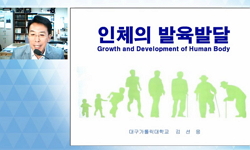Pulmonary rehabilitation remains a highly effective intervention for patients with chronic respiratory disorders and -more recently- in patients that suffered from COVID-19. Most of the evidence is obtained in patients with COPD with stable disease an...
http://chineseinput.net/에서 pinyin(병음)방식으로 중국어를 변환할 수 있습니다.
변환된 중국어를 복사하여 사용하시면 됩니다.
- 中文 을 입력하시려면 zhongwen을 입력하시고 space를누르시면됩니다.
- 北京 을 입력하시려면 beijing을 입력하시고 space를 누르시면 됩니다.
https://www.riss.kr/link?id=A107949246
- 저자
- 발행기관
- 학술지명
- 권호사항
-
발행연도
2021
-
작성언어
-
- 주제어
-
KDC
500
-
자료형태
학술저널
-
수록면
179-180(2쪽)
- 제공처
-
0
상세조회 -
0
다운로드
부가정보
다국어 초록 (Multilingual Abstract)
Pulmonary rehabilitation remains a highly effective intervention for patients with chronic respiratory disorders and -more recently- in patients that suffered from COVID-19. Most of the evidence is obtained in patients with COPD with stable disease and those that suffered from acute exacerbations. In these patients significant benefits are obtained in exercise tolerance, symptoms and health related quality of life. In that last group of patients, pulmonary rehabilitation is an intervention that significantly impacts on readmission rate and even survival.
The major problem with rehabilitation remains, poor referral, poor uptake and drop out. Alternative program formats may be part of the solution to attract more patients to pulmonary rehabilitation programs. To that end the recent consensus document of the American Thoracic Society helps to identify the essential components that should be available in alternative program formats. This document summarizes the features in terms of assessment, program components and staff training (Ann Am Thorac Soc. 2021).
The goal of exercise training as part of rehabilitation is to enhance physical fitness. Improving exercise tolerance and skeletal muscle function is not easy in patients with underlying lung disease. It requires exercise training adapted to the exercise limitation of the patient. Classic endurance training may fail to deliver a training stimulus that leads to improvements in physical fitness. Alternative forms of exercise training have been adopted. These forms of training are important in patients with more advanced disease and include for example interval training, downhill walking (an eccentric muscle stimulus that alleviates the ventilatory burden), resistance training. When used properly, these training forms improve skeletal muscle function, and restore oxidative capacity of the skeletal muscle without jeopardizing the comfort of patients during the exercise training. Aside from improving physical fitness appropriate exercise training also alleviates symptoms of dyspnea and fatigue. Overall these improvements exceed what can be expected from pharmacotherapy, but obviously the combination of pharmacotherapy and exercise training may yield even better effects.
Another important insight in rehabilitation is that achieving the goal of enhancing physical activity is not necessarily achieved simply by enrolling patients in an exercise training program. Patients need to change their inactive life style towards a more active life style. This works better when their exercise capacity is optimized first. Enhancing physical activity can be supported by an activity coaching program. Such programs can be offered as tele-coaching where patients monitor their behavior and are receiving feedback on achieving (or not) the agreed physical activity goals. Such programs can be added to regular rehabilitation programs when the exercise tolerance is optimized. Improvement of physical activity allows patients to use the acquired exercise tolerance in daily life and may be important to maintain the benefits of the training program as long as possible.
In summary, pulmonary rehabilitation remains a highly effective intervention and it can be offered in several modalities, provided they adhere to basic requirements. Training programs can be adapted to the physiologic limitations of patients. While exercise training improves exercise capacity, behavioral change programs are needed to improve physical activity and complete the effects of rehabilitation.
동일학술지(권/호) 다른 논문
-
Clinical Implications of Ischemic Stroke in Patients with Pulmonary Embolism
- 대한결핵 및 호흡기학회
- ( Yong Hoon Lee )
- 2021
-
Assessment of Sleep Patterns of Critically Ill Patients: A Pilot Study Using a Portable EEG Monitor
- 대한결핵 및 호흡기학회
- ( Joon Han Kim )
- 2021
-
- 대한결핵 및 호흡기학회
- ( Hye-ryeon Heo )
- 2021
-
- 대한결핵 및 호흡기학회
- ( Eun-sook Park )
- 2021




 KISS
KISS






